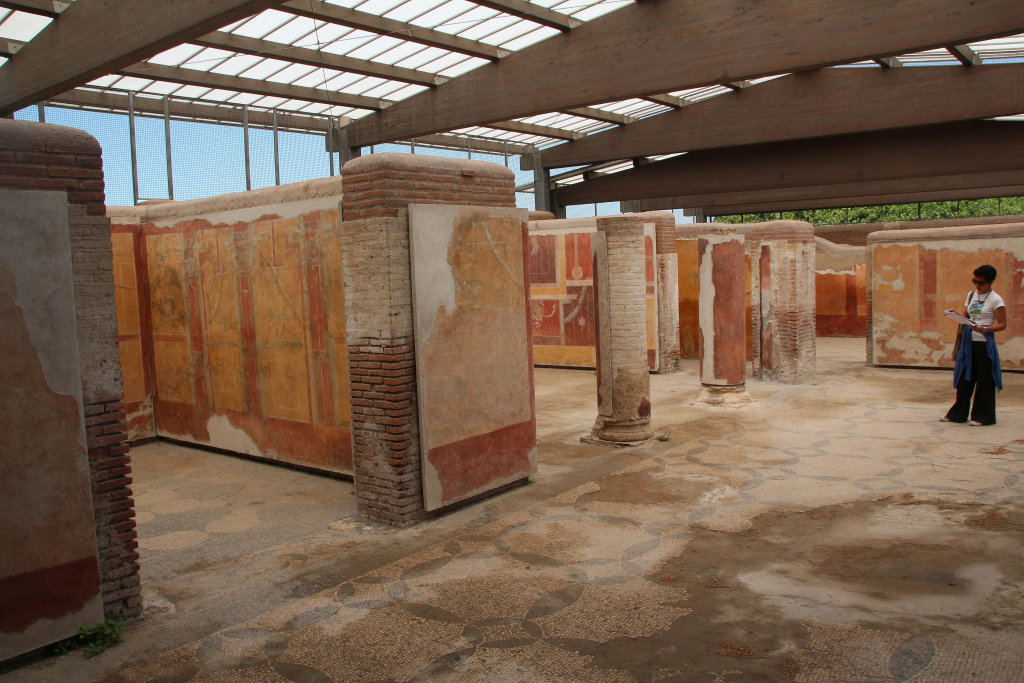|
The House of the Priestesses (also called House of Lucceia Primitiva) is part of the outer circle of the Hadrianic Garden Houses. It was excavated in the years 1938-1942 and 1969-1970. The building was destroyed in the last quarter of the third century, witness coins from the reigns of Gallienus (253-268) and Aurelianus (270-275). The ceiling of the ground floor and the upper stories had collapsed. Traces of fire are not reported, and the cause of the destruction seems to have been an earthquake. The ruins were not cleared in antiquity. However, windows and doors above the destruction layer of the late third century were blocked, probably in the fourth or fifth century, suggesting habitation. The building is a medianum apartment. In the east facade are eight windows and, at the south end, a door leading to a corridor. In the west facade are seven windows, and here too is a door to the corridor. All openings in this facade were later blocked. In the windows were wooden frames for glass window-panes, witness imprints in the plaster. To the west of entrance-corridor 1 are kitchen 2 and internal staircase 3. Most other rooms open off the "room in the middle", medianum 5. The position of main room 6 - on the long side of the medianum - is atypical, as are the two round, brick columns in the entrance of this room. The room was presumably two stories high. The floors of all rooms, with the exception of the kitchen, are decorated with geometric black-and-white mosaics. The building is famous for its painted decoration, on walls and ceilings, exceptionally well preserved. The paintings on the ceilings were applied on canes tied together with ropes and attached to a wooden support with iron nails (in Italian: "camera a canna"). The paintings have been dated to the years 130-140 AD, so belonging to the first building phase. Room 4 was a secondary representative room. Above a yellow socle, white Ionic, fluted columns separate red and yellow panels. Inside the panels are futher panels, red and dark-red, with architectural elements, garlands, and floating figures: dancing male and female figures, a bird, sea horses, dolphins, musical instruments and a mask. About one-third of the (collapsed) ceiling of room 4 has been found. It has been recomposed of many small fragments (unfortunately not on display in the building). Depicted are horses, priestesses, flowers, and heads (of winds?). These are vaguely dionysiac subjects, as are those in room 6. In a hole a chain was fastened for suspending a lamp. Room 6 was the main representative room. The decoration of the walls is very similar to that in room 4, but many variations can be seen in the distribution of the colours and the floating figures: dancing figures, vessels with flowers, hippocamps, spheres, and cornucopiae flanking a head. The ceiling had collapsed, but most if it had been preserved. The painting imitates a cross-vault. Depicted are hippocamps, satyrs, maenads, a centaur, flowers, birds, cornucopiae, the skin of a sacrificial animal, muses, priestesses, mythological animals, theatrical masks, vessels with fruit, a poet (?), Dionysos and Ariadne (?), and the young Dionysos (?). Further variations in the wall paintings can be seen in several other rooms, but all walls are dominated by solid red and yellow panels, with white columns and lines, and some green. On the north wall of room 4, to the right of the doorway, a graffito can be seen with the date July 21. It was probably written with a stilus, on red plaster:
A woman named Lucceia Primitiva promises that she will thank a deity, Fortuna Taurianensis, when she and those who are dear to her will be in good health, after a danger which was mentioned in the first, mutilated line. It is unlikely that this Fortuna is the protective deity of Taurianum, a town in the south of Italy. More likely there is a relation with the cognomen Taurianus, that is documented in the Temple of Serapis (III,XVII,4). |
 Plan of the house. Falzone-Pellegrino 2001, fig. 1. |










